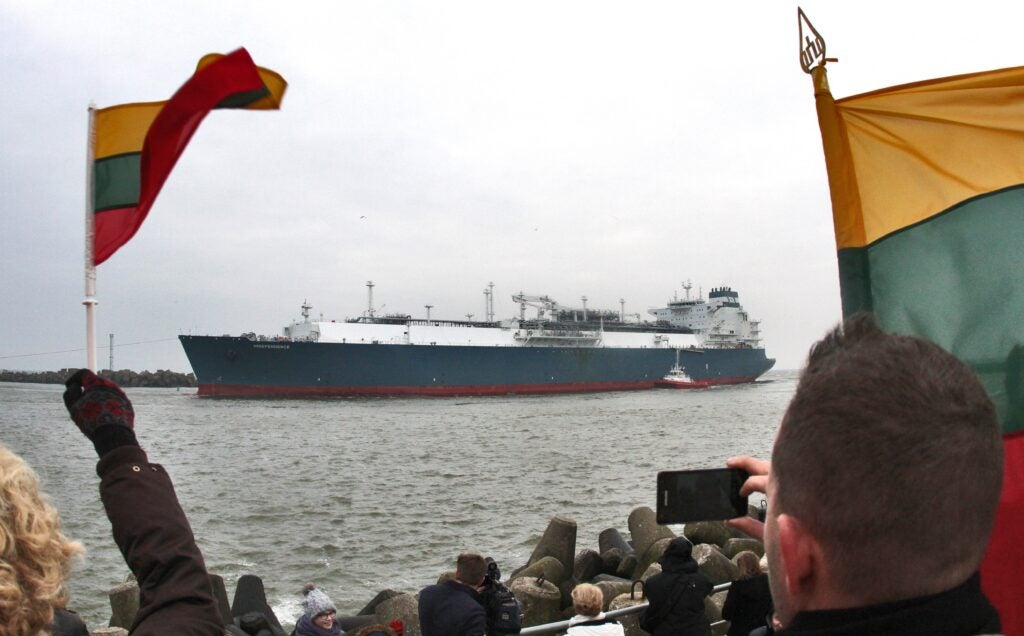Lithuania has ceased Russian gas imports. “Seeking full energy independence from Russian gas, in response to Russia’s energy blackmail in Europe and the war in Ukraine, Lithuania has completely abandoned Russian gas,” Lithuania’s energy ministry said on 2 April.
The country’s gas transmission system operator, Amber Grid, has confirmed that all Lithuanian natural gas demand is being met through the Klaipėda liquefied natural gas (LNG) terminal, which started operations in 2014. Prior to that year, all gas demand was met by Russia’s Gazprom.

Discover B2B Marketing That Performs
Combine business intelligence and editorial excellence to reach engaged professionals across 36 leading media platforms.
Energy Monitor’s weekly data shows that the main source of LNG at Klaipėda has been and remains Norway, although the US increased its deliveries to the Baltic country in 2020.
Norway had already boosted its gas delivery potential before the Ukraine war started, in a bid to help Europe shed its dependency on Russia.
Following the war's outbreak, Norwegian state-owned energy company Equinor announced in March 2022 it would increase both exports and production permits, raising the production capacity of the Oseberg field by around one billion cubic metres and that of the Heidrun field by 0.4 billion cubic metres. This equates to the gas demand of 1.4 million European homes for a calendar year (for comparison, Lithuania’s population is 2.7 million.)
Despite its relatively small size, Lithuania became the top destination for Norwegian LNG in 2020, ahead of France, Spain and Poland by a considerable margin.

US Tariffs are shifting - will you react or anticipate?
Don’t let policy changes catch you off guard. Stay proactive with real-time data and expert analysis.
By GlobalDataThe 2.9 million tonnes annual operating capacity of Lithuania’s LNG import terminals pales next to Japan, the world leader at 227 million tonnes, or Spain, at 44 million tonnes. As of now, there are no other LNG terminals planned or under construction in Lithuania.
The Klaipėda LNG terminal, however, may have untapped potential. Klaipėdos Nafta, the terminal's operator, reports significant unused capacity – the terminal's use rate was around a steady 30% up to 2018, rising to 50% in 2021.

Lithuania and the other Baltic states – Estonia and Latvia – are not yet connected to the European gas grid. This will change with a new gas interconnector between Poland and Lithuania, due to be completed in October 2022. This pipeline will enable natural gas to be transported in both directions, integrating the Baltic (and Finnish) markets into the common European gas market. Lithuania’s state-owned energy company has hinted at the potential to export gas to Poland, sourced from the Klaipėda terminal.
While Lithuania has stopped any imports of Russian gas for domestic consumption, Russian gas still flows through its pipelines – Gazprom has a long-term transit contract until 2026 for the delivery of gas to Kaliningrad, Russia’s exclave on the Baltic Sea.
Finally, despite Klaipėda's success, natural gas is on the decline in the power sector in Lithuania, with 2021 the first year in which wind surpassed gas in the country’s power mix.
As for total energy consumption, natural gas has been on a downward slide since 2011 when it reached a record high of 47%. This continued until 2019 when natural gas's role in energy consumption reached 31% and started growing again, reaching 34% in 2020. As Lithuania also targets 100% of electricity from renewables by 2050, the future role of the Klaipėda LNG terminal remains to be seen.





